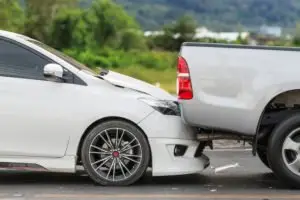
Tailgating occurs when one vehicle is following too closely to another. Whilst tailgating is a fairly common occurrence in the State of Florida, it can have incredibly dangerous consequences. If a vehicle is following you too closely and you need to brake sharply, this can lead to rear-end collisions, which can cause serious injuries and significant property damage.
If you were involved in an accident where a driver was following you too closely, you need to prove that you were not at fault by working with a car accident attorney. Here at The Law Place, we can help you to achieve this by looking at all available evidence in order to defend you against any liability claims from other drivers and to pursue compensation for damages.
We’re a Florida-based law firm committed to offering excellent service to all of our clients. We’re also externally rated by AVVO and have specific experience working on both personal injury and traffic accident cases.
For your free consultation, contact our office today at (941) 444-4444.
What Evidence Can Be Used to Show Tailgating?
If you were hit by another driver who was following too closely, this could put you in a difficult situation. The driver who hit you may claim that, although they rear-ended you, this was due to your own negligence. They could say, for example, that you gave no indication that you were going to brake suddenly or that you were weaving in and out of traffic and that this is what caused the rear-end collision.
However, if this does happen, you can work with a car accident attorney to try to prove that the accident was not your fault. They’ll be able to gather evidence to prove that a vehicle was not observing a safe following distance by using information such as:
Video Evidence
One of the most reliable forms of evidence is photos and videos. This can show an unbiased view of exactly what took place. If your accident occurred on a busy stretch of a Florida highway or a built-up area, such as a parking lot or city center, it’s likely that video surveillance in the form of security cameras will have captured the incident. This can be used to find out the distance between your vehicle and other vehicles involved in your accident.
In addition, if you or the driver who hit you had a front or rear dash cam installed on their vehicle, this could shed light on the distance between the two vehicles when the accident occurred.
The Crash Report
After a car accident, a crash report will need to be filled out. This report can be crucial in determining why a rear-end accident occurred as it contains the attending officer’s own assessment of the situation, including who they believe was at fault for the accident. This is not always 100% accurate, as a police officer can sometimes make mistakes, especially if they did not witness the accident itself. So, if a police report has determined that you were at fault for the accident, you can still work with an attorney to try to get this overturned.
In addition, the finalized crash report will often have diagrams of the accident scene completed by a reconstruction specialist. This uses factors such as skid marks on the road, vehicle damage, and traffic conditions to determine fault.
Witness Statements
Whilst witness statements can be biased, especially if they come from someone who only witnessed an accident from one point of view, they can still be useful when it comes to proving fault. Police will also take driver’s statements from those involved in the crash.
If an accident occurs on a busy road or highway, it’s possible that witnesses may not stop to give an account of the accident they have witnessed. However, if video surveillance manages to capture license plates of people who may have seen the incident, they could be tracked down for questioning.
Event Data Recorders (EDRs)
According to the United States Department of Transportation, if the rear driver who hit you was a commercial vehicle, it’s likely that they will have an Event Data Recorder (EDR) attached. These are often referred to as a ‘black box’ and can show information such as:
- The length of time that the vehicle was operational without a rest break.
- The speed of the vehicle at the time of the accident.
- The braking patterns of the vehicle.
- Steering angles.
- Seatbelt use.

What to Do if You’re Involved in a Tailgating Accident
If you’re an accident victim who was hit by a driver following too closely, there are some key things you should do before and after the accident in order to keep yourself safe and legally protected:
Remain Calm and Stay at the Accident Scene
According to Florida Statute 316.062, you need to stay as close as possible to the accident scene without risking your own safety. You’ll need to render aid to anyone who may be injured and also contact the relevant authorities to report the accident if none have arrived at the scene of the crash. You’re also obligated to comply with their requests for information as they will ask for your driver’s license, name, address, and vehicle registration.
It can be intimidating to stop and face the consequences of a traffic accident, even if you do not believe you were at fault. However, if you flee the accident scene, you could face criminal charges for a hit and run case which, according to Florida Statute 316.061, is classed as a second-degree misdemeanor.
Go to the Hospital Within 14 Days
It’s crucial that you receive medical attention as soon as possible after an accident. It should be your priority to keep yourself safe and healthy and to ensure any injuries are assessed. You should make sure to do this even if you don’t feel seriously injured as you need to be seen within 14 days to be eligible to receive compensation for damages.
Make sure to keep any medical records and associated medical costs because you will need this information if you intend to pursue compensation at a later date.
Contact Your Insurance Company
Usually, you are required to report to your insurance company that an accident took place within 24 hours. However, you will need to inform them of the event without going into too much detail until you have received legal advice from an attorney. At this stage, you should never discuss or downplay your injuries, go into detail about the extent of any property damage, or sign any legal documentation.
Contact a Car Accidents Lawyer
Working with a car accident and personal injury lawyer will be key if you need to defend yourself against any liability and pursue compensation for any injuries you may have sustained during the accident.
In addition, an attorney will be able to handle all communications with your insurance company and make sure all paperwork is completed. They’ll also be able to advise you on what your next steps should be, including whether you should file a claim to achieve a settlement or sue the other driver for negligence.
Whilst it’s important to make sure you find a legal professional who is right for you and your case, time really is of the essence when it comes to finding legal representation. According to Florida Statute 95.11, the statute of limitations for personal injury cases is 4 years – and it can sometimes take 2-3 years for your case to reach a court of law if you choose to file a lawsuit.
However, you shouldn’t commit to an attorney who you don’t feel you can trust. So, make sure to choose a law firm that offers a free case evaluation to make sure you’re confident with your choice.
 We’re here to serve you. Our phones are open 24 hours a day.
We’re here to serve you. Our phones are open 24 hours a day.
The Law Place – Car Accident and Personal Injury Lawyers
Rear-end car accidents caused by another driver following too closely can have devastating consequences for accident victims. If you’ve been affected by this type of accident, contact The Law Place today. We can help you to prove negligence and receive fair compensation for lost wages, physical injuries, medical bills, and more.
To explore your legal options in a free consultation, contact The Law Place today on (941) 444-4444.



